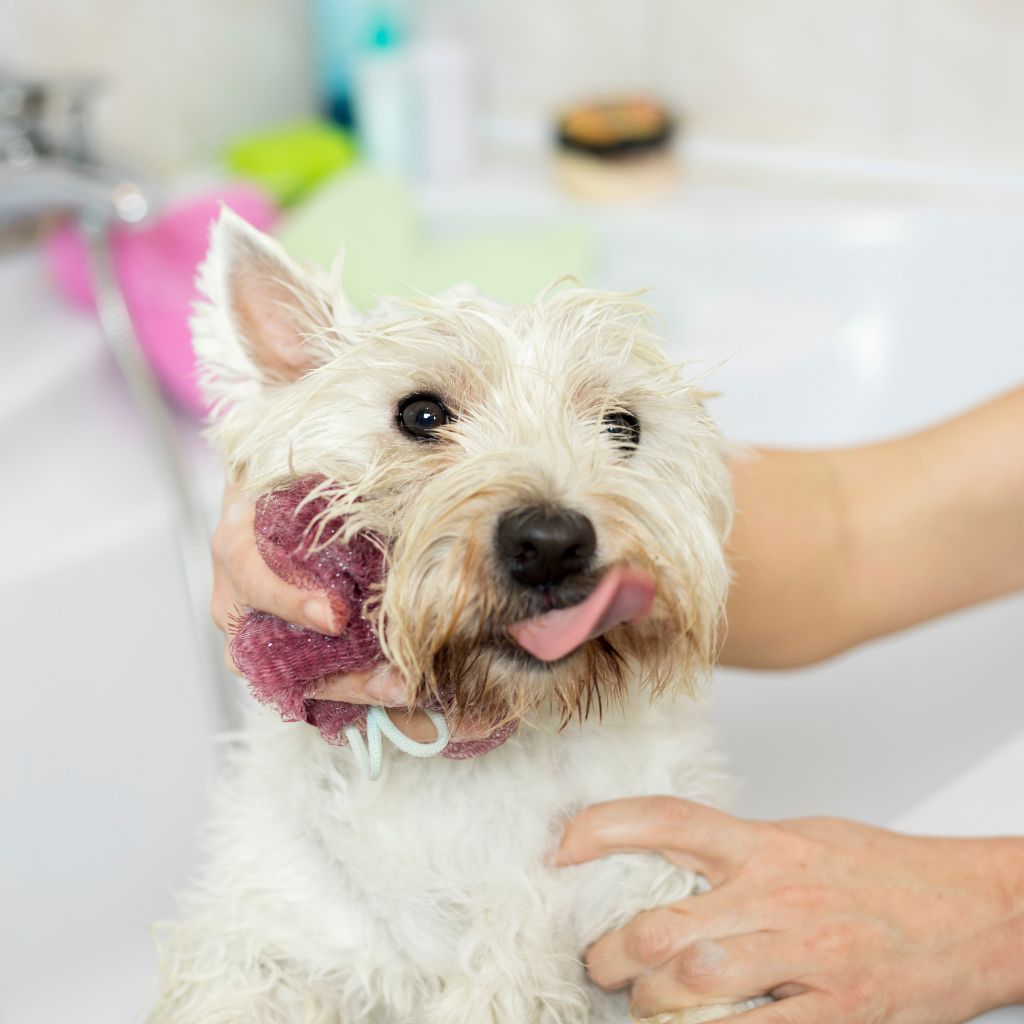
Are Epsom Salts Safe For Dogs & Cats?
Epsom Salts for Dogs and Cats?
Firstly - What is Epsom Salt?
Epsom salt, named for a bitter saline spring at Epsom in Surrey, England, is not actually salt but a naturally occurring pure mineral compound of magnesium and sulphate. Long known as a natural remedy for a number of ailments, Epsom salt has numerous health benefits as well as many beauty, household, and gardening-related uses.
Studies have shown that magnesium and sulphate are both readily absorbed through the skin, making Epsom salt baths an easy and ideal way to enjoy the associated health benefits. Magnesium plays a number of roles in the body including regulating the activity of over 325 enzymes, reducing inflammation, helping muscle and nerve function, and helping to prevent artery hardening. Sulphates help improve the absorption of nutrients, flush toxins, and help ease migraine headaches.
The Epsom salts for dogs can be helpful for dogs suffering from allergies, for treating open wounds, relieving skin discomfort and relieving aches in muscles. The only thing you should watch over is your dog not to drink water with Epsom salt, because it can disrupt its digestive system. Before you start using a bath with Epsom salts for dogs, you should know the benefits.
Benefits of Epsom Salt
- Helps remove toxins
- Promotes healing
- Natural anti-inflammatory
- Helps relieve chronic pain
- Soothes sore and inflamed paws
- Reduces swelling
- Reduces stiffness of arthritis
- Relieves muscle aches
- Eliminate toxins and soothe the skin such as with eczema
- Effective in reducing the symptoms of allergies
- Boosts brain neurotransmitters that help reduce stress and anxiety
- Helps against bites
- Can help with heavy metal detox
- Good for sunburn
- Aids healing of minor wounds
- Helps with anal gland problems
- Good for helping treat flea infestations and as a flea preventative
EPSOM SALT AND DOG = Epsom salt can help to heal wounds, alleviate pain and even reduce stress.
But is this chemical compound, magnesium sulphate, beneficial for dogs too?
Here’s the deal : Epsom salt is safe, but only if you prevent your dog from drinking the bath water they’ve been soaking in.
Side Effects… please be careful
- Do not give orally to your cat or dog
- May have a laxative effect in some cats and dog.
- Could interfere with medications.
- If overused dehydration may occur
THE TRANSDERMAL APPROACH
Epsom salts are used in our pool as they provide many health benefits. Dissolved salts are easily absorbed through our skin making it the best way to boost our magnesium levels aside from food intake. Transdermal intake of magnesium is a good way because it is less affected by activity in your gut, such as stomach acids and digestive enzymes. When the liver and stomach are bypassed, more of the magnesium goes directly into the bloodstream.
What is Transdermal Absorption?
Transdermal means the application of a medicine or drug through the skin. In the simplest terms, a drug is placed on top of the skin, where it is absorbed into the bloodstream. Transdermal medications have many advantages, chief among them ease of application. Medications that can be absorbed through the skin bypass the need for pills or liquids, which can be a challenge to administer to some pets. In addition, because they are absorbed directly into the bloodstream, and avoid initially passing through the intestinal and liver, transdermal application may be more effective or work faster than some oral medications, allowing better treatments.
- Soothing relief from arthritic pain
- Reducing stiffness, soreness, and tightness of joints
- Reducing discomfort from muscle aches, pains and tenderness
- Soothing painful bruises, sprains and strain
- Improving body energy levels to accelerate the rate of natural body healing
- Deep cleansing of the skin
Epsom salt baths are useful for many reasons. Epsom salt is healing and soothing. It relaxes tired, sore muscles as well as improves nerve functions. If your dog has dry, itchy skin, an Epsom salt bath can soothe and relieve tender skin. If your dog has been injured or is healing from surgery and can take wet baths, Epsom salt can assist with quicker healing and improve swelling. An Epsom salt bath can also gently soothe wounds. Your dog’s feet see so much of the world and are often the first thing to become injured. Sticks and stones cause harm to tender paw pads, while stepping on sharp objects can cause injury. An Epsom salt bath can relieve much of these injuries while soothing minor scratches and keeping your dog’s paws in great condition for daily walking and running.
Dog's Perspective:
Your dog may not enjoy baths altogether, or he may be tender and sore, causing apprehension about bathing. If this is the case, you may need to work up to a soaking Epsom salt bath over time. A quick Epsom salt treatment and a treat reward might help in these cases.
Step 1. Prepare!
If your dog is dealing with a small injury such as one paw or one area on his skin, you can Epsom salt treat or soak that area without submerging your entire dog in an Epsom salt bath. To do this, prepare your dog and the area you need soaked. If it needs to be brushed or shaved to reveal the injury, do this before you're ready for the soaking.
Step 2. Epsom salt soak!
Prepare a bowl of warm water and Epsom salts. You will want to add about a cup of Epsom salt per gallon of water. If your bowl is smaller than a gallon, measure accordingly. The measurements do not have to be exact.
Step 3. Soak!
Set the area on your dog you would like to have treated with an Epsom salt bath in a place you can soak in the bowl. If instance, if it is a paw, just place this area inside the bowl and let it soak for about 10 minutes. If this is not an area you can place inside a bowl or container, you will need to do an Epsom salt rinse.
Step 4. Epsom rinse!
Place your dog somewhere where you can pour water over the injured or affected area and have it drip down either into a tub or bowl, or onto the ground outside. When you have the area isolated and your Epsom salt bath ready, just pour small amounts of your Epsom salt water over the affected area. You will want this area to be wet with the Epsom salt for several minutes to be effective.
Step 5. Clean rinse!
Once you are done either soaking the affected area or Epsom rinsing the affected area, be sure to give your dog a nice clean rinse with clear running water. To do this, you can have a second bowl prepared with clean water and have your dog soak in that bowl for a few moments or have clean water ready to pour over your dog's Epsom soak area just to give it a nice clean rinse.
Step 6. Treatments!
If you are treating an injury or affected skin such as dry patches or healing wounds, you will want to do an Epsom rinse or soak at least twice a day until the injury has fully healed.
Step 7. Reward!
Be sure to reward your dog for a job well done, patience, and tolerance at the end of every Epsom salt soak or rinse
Go with half a cup for each 5litres of warm water, but you don’t have to be super precise with the solution.
And there’s no need to rinse off the treated area afterwards.
Epsom salts are not highly toxic. Some licking is unlikely to cause harm.
Fact: Salt, in poultice form, is commonly used to treat horses for painful hoofs and muscle soreness. It’s a winner.
Epsom Salt: It will help relieve a strained muscle and treat abscessed nail beds and paws that are itchy due to allergies. Add ½ cup Epsom salt to a warm bath and let your dog soak for five minutes, twice daily. If your dog doesn’t agree with you on this method, you can soak a washcloth in Epsom salt and warm water and apply just to the local area.
How to Use Epsom Salt for Cats (& Dogs)
Use Epsom salts externally only with your pet.
Buy Epsom salts in their natural state. Do not use Epsom salts that are fragranced or coloured/dyed with your pet.
- Epsom salt bath. Place about ½ cup of Epsom salt to 1 gallon/ 4 litres of water and bathe your dog with the healing salts. Make sure your dog does not drink the water. Once you've bathed your dog, thoroughly rinse him/her with clean water to ensure all the Epsom salt water is washed away. Epsom baths are great for those animals that have skin issues as they will help exfoliate and soothe the skin of your pet.
- Alternatively, you could do a sponge bath instead of immersing your pet in a full bath. Again properly sponge down your cat or dog with clean water after the Epsom salt sponge bath. Ensure your cat or dog doesn't drink any of the bathwater and with cats, that they don't lick themselves with the Epsom salt water.
- Make an Epsom salt compress and apply it to the affected area for 10 minutes. This is the best solution for cats if you can keep your cat quiet for the time needed to apply the compress. This will help heal and relieve aches and pains. Most cats once they feel the benefit will work with the compress to aid their healing. Remember to always clean off the Epsom salt water with clean water.
- Do a paw bath soak, depending on the size of your bowl add ½ teaspoon to 1 teaspoon of Epsom salt into warm water. Soak your pet's paws, ideally for 5 to 10 minutes, or for as long as your dog will let you. Paw baths are a great simple way to help your dog heal faster, relieve any pain or itching, help heal slight abrasions on your dog's pads and fight any possible fungal infection. Avoid paw baths if your dog has an open wound. Cats can also benefit from a paw bath, however not all cats will allow you to do this, so you may need to be pretty nifty if you're got a wriggly cat, especially if you're trying to give a paw bath on a poorly paw.
For treating bites, depending on the size of your bottle dissolve 1 tablespoon of Epsom salt in water and add to a spray bottle. Spray your pet on the bite area.
Share



